How Where Ruins of Puma Punku in Tiahuanaco, in South America
Transcript of the conference by Prof. Joseph Davidovits, held at the Geopolymer Camp 2018, in the Session: Ancient Technologies, Tuesday, July 10, 2018, titled: "Joint Research Program Conducted by the Geopolymer Institute and Universidad Catolica San Pablo, Arequipa, Peru, First Scientific Results on Tiahuanaco / Pumapunku Megalithic Monuments (Tiwanaku), Bolivia."
This study is also available in the GEOPOLYMER LIBRARY for free download. Go to #K-eng. Tiahuanaco geopolymer artificial stones
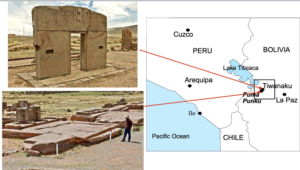
Contents:
- Extended abstract
- Introduction
- Part 1. Pumapunku red sandstone megaliths
- 1.1 Geological provenience of the megalithic sandstone blocks
- 1.2 Scientific investigations: thin sections, optical microscope. X-rays diffraction, SEM / EDS, scanning electron microscope.
- 1.3 Discussion.
- Part 2. Pumapunku gray andesite volcanic structures
- 2.1 Extravagant and puzzling structures.
- 2.2 Scientific investigation: thin sections, optical microscope, SEM/EDS, scanning electron microscope.
- 2.3 Discussion: which chemistry ?
- 3. Conclusion
The video of the Geopolymer Camp 2018 conference presenting all the results in detail.
"The Megaliths at Tiwanaku / Pumapunku are artificial geopolymers."
61 min, 272 MB. Click on the CC icon to display subtitles in english, français, espanol. Click on the icon on the right to watch it fullscreen. Available on Youtube !
"Los Megalitos de Tiwanaku / Pumapunku son Geopolímeros Artificiales"
61 min, 272 MB. Click on the CC icon to display subtitles in english, français, espanol. Click on the icon on the right to watch it fullscreen. Available on Youtube !
This study is also available in the GEOPOLYMER LIBRARY for free download. Go to #K-eng. Tiahuanaco geopolymer artificial stones
Extended Abstract
The first results of this research were published recently in leading international scientific journals:
- On the geopolymer sandstone megalithic slabs: J. Davidovits, L. Huaman, R. Davidovits, "Ancient geopolymer in South American monuments. SEM and petrographic evidence ", Materials Letters 235 (2019) 120-124. DOI: doi.org/10.1016/j.matlet.2018.10.033, on line 8 October 2018.
- On the geopolymer andesite volcanic "H" structures: J. Davidovits, L. Huaman, R. Davidovits, "Ancient organo-mineral geopolymer in South American Monuments: organic matter in andesite stone. SEM and petrographic evidence", Ceramics International 45 (2019) 7385-7389, DOI: doi.org/10.1016/j.ceramint.2019.01.024, on line 4 January 2019.
The study carried out on the monumental stones constituting the Pumapunku site in Tiahuanaco, Bolivia, proves that the stones are artificial and are not carved with unknown technology or by extraterrestrials. It is the human genius, intelligently exploiting the resources of its environment, who created these marvels.
Tiahuanaco, on Lake Titicaca in Bolivia, is a village known throughout the world for its mysterious Gate of the Sun, ruins of temples and its pyramid. Archaeologists consider that this site was built well before the Incas, around 600 to AD 700. The site of Pumapunku is right next door with the ruins of an enigmatic pyramidal temple built at the same time. Because it is not restored and developed for touristic activity, it is less known to the general public. However, there are two architectural curiosities there: four giant red sandstone terraces weighing between 130 and 180 tons and small blocks of andesite, an extremely hard volcanic stone, whose complex shapes and millimetric precision are incompatible with the technology of the time. And for good reason, since archeology tells us that the Tiwanakans had only stone tools and no metal hard enough to carve the rock. But they would have carved the gigantic blocks of red sandstone (these ancient blocks are the largest of all the American continent!) and they were able to carry these hundreds of tons on the site, then to adjust them precisely. Also, they would have been able to carve other smaller blocks made of volcanic andesite, an impossible-to-carve stone with an incredible finish! Archaeologists cannot give any rational explanations on how this was possible. Therefore, for the general public, the assumptions generally advanced to explain these wonders are the achievement by a lost ancient super civilization or by aliens' involvement.
In November 2017, the scientists gathered samples taken in the red sandstone and andesite from the Pumapunku site. For the first time, these stones were analyzed under the electron microscope, this had never been done before! They discovered the artificial nature of the stones. They compared the monuments' stones with the local geological resources and found many differences.
Andesite rock is a volcanic stone from magma. It is composed mainly of silica in the form of plagioclase feldspar, amphibole and pyroxene. But the scientists have discovered the presence of an organic matter based on carbon. Carbon-based organic matter does not exist in a volcanic rock formed at high temperatures because it is vaporized. It is impossible to find it in andesite rock. And because we found organic matter inside the volcanic andesitic stone, the scientists will have the opportunity to carry out a Carbon-14 dating analysis and provide the exact age of the monuments. This organic element is a geopolymer based on carboxylic acids which was therefore added by human intervention into andesite sand to form a kind of cement.
The giant blocks of red sandstone raise another problem. Sandstone is a sedimentary rock composed of quartz grains and a clay binder. There are several possible geological sources but none correspond to the stones of the archaeological monuments. No known quarry is able to provide massive blocks of 10 meters long. In addition, the local stone is friable and small in size. The scientists have discovered under the electron microscope that the red sandstone of Pumapunku cannot come from the region because it contains elements, such as sodium carbonate, not found in the local geology. Therefore, where does the stone come from? From hundreds to thousands of kilometers? With what means have they been transported? In fact, electron microscopic analysis proves that the composition of the sandstone could be artificial (a ferro-sialate geopolymer) and manufactured to form cement.
What is this technology mastered by the Tiwanakans? Artificial stones were formed as cement. But, it is not a modern cement, it is a natural geological cement obtained by geosynthesis. For this, they took naturally friable and eroded rock like red sandstone from the nearby mountain, on the one hand, and on the other hand, unconsolidated volcanic tuff from the nearby Cerro Kapia volcano in Peru to form andesite. They created cement either from clay (the same red clay that Tiwuanakans used for pottery) and sodium carbonate salts from Laguna Cachi in the Altiplano Desert to the south, to form red sandstone. For gray andesite, they invented an organo-mineral binder based on natural organic acids extracted from local plants and other natural reagents. This cement was then poured into molds and hardened for a few months. Without a thorough knowledge of geopolymer chemistry, which studies the formation of these rocks by geosynthesis, it is difficult to recognize the artificial nature of the stones. This chemistry is not a difficult science to master. It is an extension of the knowledge of Tiwanakans in ceramics, mineral binders, pigments and above all an excellent knowledge of their environment. Without the selection of good raw materials, these extraordinary monuments could not have been created 1400 years ago.
Finally, this scientific discovery confirms local legends that say, "The stones were made with plant extracts able to soften the stone." This explanation has always been rejected by archaeologists because it made no sense. The evidence provided by the team of scientists from France and Peru shows that the oral tradition was right: they made soft stones that could harden! The hypothesis of the lost ancient super civilization or alien intervention is false. Tiwanakuans were intelligent human beings. They knew their environment perfectly and knew how to exploit the resources brought by nature.
In addition to the Carbon-14 dating analysis, further studies will soon be carried out to determine whether certain monuments in the Cuzco region of Peru have been built with the same scientific knowledge.
This study is also available in the GEOPOLYMER LIBRARY for free download. Go to #K-eng. Tiahuanaco geopolymer artificial stones
Introduction
Preliminary results on Tiwanaku / Pumapunku monuments were recently published [1, 2]. Some of their methods of construction have long been a matter of interest and speculation involving super-civilizations or alien intervention. Conventional theories suggest that the constituent stone blocks were cut from quarries sometimes remotely located, accurately dressed and lifted into position. There is currently little research being done by material scientists on these controversial topics. However, from a construction and building material point of view, the knowledge that can be acquired through this type of archaeological study is manifold. In particular, it generates examples that are useful for the determination of the long-term properties of geopolymer concretes. It helps understanding of the chemical transformation which a geopolymer matrix can undergo over a long time range (hundreds if not thousands of years), and provides data on the crystallization mechanism and mineralogical evolution.
For the Egyptian pyramids, in the 1980s Joseph Davidovits, who is known for his development of geopolymer science and geopolymer concrete [3], proposed an alternative, but still controversial theory [4, 5]. He suggested that the blocks were a type of early concrete consisting of disaggregated limestone from the Giza plateau, Egypt, cemented by a sodium or potassium polysilico-oxo-aluminate, poly (sialate) geopolymer binder, and cast into blocks in situ. Despite the strong opposition of the Egyptian government [6], several scientists published studies which confirm the presence of archaeological geopolymer concrete in the pyramids [7, 8, 9, 10]. Civil engineers generally understand the implications resulting from this new paradigm of archaeological megalithic monument construction.
We present here our preliminary research results on monuments in the South American Andes, on the Altiplano (Fig. 1), namely Tiwanaku (in Spanish Tiahuanaco). It is located south-east of the Lake Titicaca at 3820 m above sea level. It comprises an earthen pyramid and the famous monolithic Gate of the Sun, made out of volcanic stone, andesite. They were built 1400 years ago (ca. AD 600) by the Tiwanaku Empire, one of the civilizations of the pre-Columbian Americas [11].
Our research focuses on the less known adjacent site of Pumapunku. In 2015 the Bolivian government started an ambitious project aimed at promoting this strange and little-known site. Its official report (2015-2020, C.I.A.A.A.T) reads (English translation from Spanish): " … the upper platform of the pyramid presents the most astonishing vestiges. Huge [red sandstone] blocks, the largest in the monumental area of Tiwanaku, lie scattered as if a large earthquake had devastated the area. The large blocks of red sandstone, mixed with fragmented doors in andesite, covered with carved decorations, is all that can be distinguished today. The ashlars with geometrical and symmetrical reliefs, perfectly polished are the silent witnesses of those majestic and important constructions of Pumapunku in the past".

Fig. 2 is the tentative reconstruction of the site. The sandstone temple itself is very small. The platform on top of the 4-step pyramid of Pumapunku consists of 4 megalithic red sandstone slabs marked in red Nr 1, Nr 2, Nr 3, Nr 4, weighing between 130 and 180 tonnes each (Fig. 3), the largest among the New World monuments. In recent years, several reports and videos have been flourishing on the Internet. Some civil engineers state that the monuments are made of a type of concrete. Others claim that they were built by super-civilizations with unknown technologies. Our study suggests that the slabs are a type of sandstone geopolymer concrete cast on the spot. There are no quarries in the vicinity whence the megalithic blocks used in the monument could have been brought in.

One early Spanish conquistador chronicler, Pedro de Cieza de Leon, who visited Lake Titicaca on the Altiplano in 1549, marveled over the ruins of Pumapunku, wondering what tools could have been used to achieve such perfection (English translation [12]) " In another, more to the westward [of Tiwanaku], there are other ancient remains, among them many doorways, with their jambs, lintels, and thresholds, all of one stone. But what I noted most particularly, when I wandered about over these ruins writing down what I saw, was that from these great doorways there came out other still larger stones upon which the doorways were formed, some of them thirty feet broad, fifteen or more long, and six in thickness. The whole of this, with the doorway and its jambs and lintel, was all one single stone. The work is one of grandeur and magnificence when well considered. For myself I fail to understand with what instruments or tools it can have been done; for it is very certain that before these great stones could be brought to perfection and left as we see them, the tools must have been much better than those now used by the Indians (….) Another remarkable thing is that in all this district there are no quarries whence the numerous stones can have been brought, the carrying of which must have required many people. I asked the natives whether these edifices were built in the time of the Incas, and they laughed at the question, affirming that they were made before the Incas ever reigned, but that they could not say who made them…." According to modern archaeology, the monument was destroyed around AD 900, i.e. 500 years before the rise of the Inca Empire.
The most controversial aspect of the Pumapunku site is, however, found in puzzling smaller items, 1 meter high, made of andesitic volcanic stone (Fig. 4). They have unprecedented smooth finishes, perfectly flat faces at exact 90° interior and exterior right angles. Historian architects are wondering how such perfect stonework could have been achieved with simple stone tools [13]. Our study demonstrates that these architectural components were fashioned with a wet-sand geopolymer molding technique.

Part 1:
Pumapunku red sandstone megaliths

Figure 5 displays the four big slabs, number (1), number (2), number (3), number (4). Number (1) is weighing 130 tons. Number (2), 180 tons; this is a monster. They are 7 to 8 meters wide in dimensions. Slab number (3) is broken and parts are vanished. Slab number (4) is broken and it has been weighing 150 tons. It is assumed that the blocks were broken very soon after construction, perhaps by an earthquake. They were repaired with cramp sockets filled with a metal (copper).
1.1 Geological provenience of the megalithic sandstone blocks
Travelers mostly agreed that the sandstone was mainly from the Kimsachata mountain range south of Tiwanaku. Yet, it remained unclear how these megaliths were quarried and transported downwards with primitive sledges on steep and narrow llama tracks as shown in Fig. 7. The first scientific studies conducted and published in the early 1970s by Bolivian archaeologists [14], set out to determine the source of the sandstone employed to construct the Pumapunku complex. They conducted geological studies in 6 drainage valleys, isolating several potential sandstone quarries, totalizing 47 samples. With comparative investigations including X-ray diffraction, XRF, geochemical analysis, and lithic petrography, they concluded that Pumapunku sandstone came from the Quebrada de Kausani (geological site (1) in Fig. 6). However, our detailed study of their published chemical analysis contradicts this.

In 2017, we took this 1970 study to start our investigation and selected three sites (Fig. 6): site (1) Quebrada de Kausani, site (2) Cerro Amarillani, already studied in the 1970s but not selected, and we added a third site, site (3), Kallamarka. Why? Because there exist several archaeological records in the village of Kallamarka, which show that the village was in activity at the time of Pumapunku construction. It is therefore clear that this village could have been associated with the sandstone material extraction. It was recently declared part of World Heritage by UNESCO in June 2014 (see below).
1.1.1 Quebrada de Kausani (KAU)
The visit to the site number (1) Quebrada de Kausani starts from the Altiplano plateau at 3850 meters and climbs up to a place called Kaliri at 4159 meters above sea level. Official archaeology is claiming that they used the steep llama track (Fig. 7) for dragging their 150 tons megaliths down to the valley. This is difficult to believe.

On the plateau, at Kaliri, there are numerous quadratic sandstone blocks lying on the ground, but we don't find any massive blocks. We have only small blocks (Fig. 8). American archaeologists [15] are claiming that these are the remains of human quarrying activity. Bolivian archaeologists are telling no, there are not! In 1970, they wrote: "typical process of disintegration by mechanical weathering (…) there were no actual sandstone quarries used by the Tiwanacotas, such as an open pit, work or gallery, but instead they went to blocks separated by diaclasis." This is a geological natural weathering event. It happens that it is producing quadratic blocks, like in other sandstone locations.

1.1.2 Cerro Amarillani (AMA)
The site number (2) Cerro Amarillani is easier to reach by car and road. It is a similar geological formation. We have also blocks. (Fig. 9)

1.1.3 Kallamarka (MAR)
The site number (3) Kallamarka (Kalla Marka) is totally different. Callamarca is the spelling in Spanish. Kallamarka with "k" is the spelling in the local language. The entrance of the village is typical and is not found elsewhere (Fig. 10). It suggests an historical background. It is astonishing clean, with a road pavement made of bricks. In fact it pertains to the famous Inca track, Qhapaq Ñan, Andean Road System, declared part of the World Heritage by UNESCO, in June 2014.

We continue our trip on the earthen road by car and leave the village, climbing up and arriving at the site that had been selected by our geologist. There, we find individual sandstone blocks, but more interesting, we have a particular feature here, namely layers of weathered soft sandstone, good for geopolymer reaction, lying in between of the quadratic blocks like displayed in Fig. 11 left.

Our geologist undertook the following experimentation on the site (Fig. 11 right) (watch the video for details) . "As you can see: you can take a very simple tool, break the sandstone down in smaller pieces, very easily…; this could be a good material to make geopolymer stone. …yes, very easy. Even with our hands we can grind it down. It's very easy."
1.1.4 Taking monument sample PP4.
The Pumapunku monument red sandstone labeled PP4 and studied here is from slab No. 2. In Fig. 5, the sampling location is marked by a black dot. In Fig. 12, it is highlighted with an arrow. It is taken from an already ancient fractured place, on the edge of the slab, where several fragments had been selected and studied in the 1970s by the Bolivian archaeologists, see the sample labeled Nr 9 (circle).

Both samples (1970 and 2017) can be compared with respect to chemical makeup and petrographic analysis.
1.2 Scientific investigations: thin sections, optical microscope. X-rays diffraction, SEM / EDS, scanning electron microscope.
1.2.1 Optical microscope: thin sections
The thin 30 µm thick sections were studied under transmitted polarized light with a Leica 4500 DMP optical microscope. The results for sandstone are shown in Fig. 13-15; the thin sections are marked KAU (Kausani), AMA (Amarillani), MAR (Kallamarka) and PP4 (Pumapunku fragment No. 4).
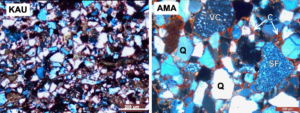
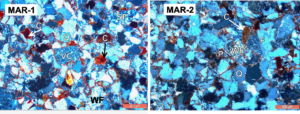
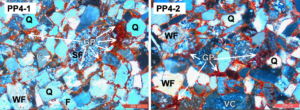
In the thin sections of Fig. 13-14-15, the size of quartz and feldspar crystals is: for KAU 100 µm, for AMA 200-400 µm, for MAR and PP4, 150-200 µm (with detrital particles of sandstone fragments similar and bigger in size). In KAU, the grains are finer and in AMA larger than those in MAR and PP4. Therefore, the red sandstone was not extracted from KAU (Kausani) nor AMA (Amarillani) and our study does not support the claims of Bolivian archaeologists [14] nor of American anthropologists [15]. They had essentially chosen the site KAU because it contains numerous natural sandstone quadratic blocks as displayed in Fig. 8. The thin section of Fig. 15 for PP4-1 and PP4-2 shows a very thick fluidal red "clay-cement" GP surrounding several detrital sandstone fragments as well as feldspar / quartz grains, This will be discussed below and described as man-made ferro-sialate geopolymer binder. The grains in the other stones have much thinner natural clay coating "C" or occasional clay clusters as in MAR-1 and MAR-2.
1.2.2 Chemical (EDS) and XRD analysis.
The scanning electron microscope SEM / EDS analysis for the elements were acquired using a JEOL JSM-6510LV scanning electron microscope. X-ray diffraction spectra were acquired using a XD8 Advance "BRUKER" AXS (Siemens) spectrometer, calibrated and interpreted according to ICDD/COD international databases from 2013. The semi-quantitative results for sandstone are listed in Table 1: chemical composition (elements at.%) and XRD mineralogical composition. KAU has quartz SiO2 and feldspar albite NaSi3AIO8, AMA has quartz and feldspar anorthite Ca (SiAIO4)2, and both MAR and PP4 have quartz and feldspar albite. We find additional minerals in MAR, namely calcite CaCO3, kaolinite and illite clays.
In Table 1, X-ray fluorescence and SEM/EDS analysis show that the KAU sample has neither B (boron) nor Ca. Later values confirm the chemical analysis of the 1970s [14] in which for 6 Kausani samples, CaO = 0%, whereas for 20 monument samples, CaO = 1.45 (medium value). In Table 1, for PP4-global, Ca = 1.70. In addition, for PP4-global, Na at.% = 9.95; this is substantially higher than for KAU (6.67), AMA (1.56) and MAR (5.10). This value is important and will be discussed below.
Table 1: Element (at.%) and mineralogical analyses for Pumapunku red sandstone and geological sandstone. X-ray fluorescence data for B boron are taken from reference [14], after [1].
| Kausani | Amarillani | Kallamarka | Pumapunku | Pumapunku | |
|---|---|---|---|---|---|
| X-R-F B boron (ppm) | 0 | 100 | not available | 100 | not available |
| SEM/EDS analysis at.% | |||||
| Na | 6.67 | 1.56 | 5.10 | 9.85 | 7.63 |
| Mg | 2.70 | 2.08 | 1.43 | 1.93 | 1.87 |
| Al | 17.18 | 13.38 | 18.48 | 16.21 | 15.43 |
| Si | 66.05 | 70.09 | 58.33 | 63.66 | 59.12 |
| K | 2.67 | 3.78 | 3.51 | 2.11 | 3.70 |
| Ca | 0 | 2.22 | 8.82 | 1.70 | 0.60 |
| Fe | 4.73 | 6.89 | 4.32 | 4.44 | 11.65 |
| XRD minerals % semi-quantitative analysis | |||||
| Quartz | 34.80 | 64.10 | 35.70 | 22.20 | – |
| Feldspar | 65.20 | 35.90 | 49.30 | 77.80 | – |
| Calcite | 0 | 0 | 7.40 | 0 | – |
| Clays | 0 | 0 | 7.60 kaolinite + illite | 0 | – |
Chemical analysis, XRF, XRD analysis (Table 1) and thin sections (Fig. 13-15) suggest that KAU and AMA are dissimilar to PP4, i.e. that the stone material PP4 of the monument does not originate from KAU (Kausani) or AMA (Amarillani) geological sites.
1.2.3 SEM analysis.
The high amount of Na measured for PP4-global in Table 1 relates to the SEM image and EDS spectrum of Fig.16, showing authigenic albite NaSi3AIO8 formed after consolidation of the sandstone. In natural sandstone, after millions of years of consolidation, the authigenic albite results from the permeation of weak alkaline waters and dissolution of the feldspar. But this requires high pressures (between 3,600 and 5,000 m depth) and temperatures (100 to 150° C) [16]. Usually, these are big crystals. Here we have a very thin uniform layer. It could be the result of the self-crystallization of a polysialate geopolymer, Si/Al=3. Because, in a Na-poly (sialate) geopolymer-based sandstone concrete, the alkaline concentration is high, the albite formation and crystallization might occur during a relatively shorter time, namely through the 1400 years of archaeological burial. But, with our present knowledge, we cannot differentiate between natural authigenic and geopolymer albite.

In Table 1, for the PP4 matrix, Fe at.% = 11.65, which is very high. It is related to the SEM image and EDS spectrum in Fig. 17. Its shows regular geometrical structures (arrows) also suggesting an authigenic formation or a geopolymeric crystallization. From the Si, Al, Fe and Na content we can classify the matrix as a "ferro-sialate" geopolymer obtained in alkaline medium [17]. Some aluminum atoms Al3+ are substituted with iron atoms Fe3+ , yielding a ratio Si/(Al,Fe)=2.3.
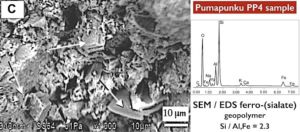
1.3 Discussion
Kaolinite clay is one of the major minerals commonly found in geopolymer synthesis and the manufacture of geopolymer concrete. MAR sandstone is subject to weathering actions transforming the feldspar into kaolinite. It is readily disintegrated into small pieces manually as shown in Fig. 11. The kaolinite quantities (in the 7% weight range) detected by the XRD analysis for MAR are high enough to start geopolymerization, provided it is combined with an alkaline medium (Na or K).
But MAR also contains calcite CaCO3, not found in PP4. However, the weathering action may vary from place to place. The Kallamarka plateau covers a large area and subsequent work on samples from this site may produce XRD spectra more similar to the present PP4 spectrum. This differentiated weathering action suggests that, in order to manufacture one of the big monument slabs, weighing up to 180 tonnes, the sandstone material could have been dug up at different locations, i.e., with different calcite content. Indeed, the petrographic analysis of the 1970s carried out on the four megalithic slabs found calcite in 15 samples, yet none in 5 others, out of a total of 20. For their two samples M9 and M12 taken in the same slab No. 2, the calcite content for M9 = 0%, whereas M12 = 12%. So, the calcite content is varying within the same sandstone block. Since our specimen PP4 was taken at the same place as the sample M9 of slab No. 2 in Fig. 5 and Fig. 12, our XRD result is correct.
In Fig. 15, the thin sections for PP4-1 and PP4-2 show the thick fluidal red ferro-sialate matrix labeled GP (white arrows) and detected with SEM in Fig. 17. To our knowledge, this feature is very unusual in sandstone formed geologically or at least it has not been reported in petrographic studies performed in the red sandstone of the area [14] [18]. The thick fluidal red ferro-sialate GP matrix displayed in Fig.17 represents a unicum and supports the idea of an artificial sandstone geopolymer concrete.
In Table 1 the Na content for PP4 global and PP4 matrix is also higher than the values for KAU, AMA and MAR. Therefore, in the assumption that PP4 is natural sandstone, it does not belong to the sandstone from the Kimsachata mountain range south of Tiwanaku. None of the analysis carried out on the 47 samples studied in 1970 contains this high amount of Na. Where does it come from? Sandstone with such a high Na content has not been located in the vicinity, so far. Therefore, if we stay with the accepted argument that the monument sandstone is natural, then, it does not belong to the region. Consequently, according to traditional archaeology, the megalithic slabs of between 130 and 180 tonnes, would have been extracted and moved from a geological site located elsewhere, far away. These giant sandstone blocks, the size of a house (8×8 meters surface area), would have been transported on primitive sledges downwards from a place similar to the KAU Kausani site located at 4150 meters altitude on a steep and narrow llama track as shown in Fig. 7. This is difficult to accept even though archaeologists have experimented with dragging small pillars (1 to 5 tonnes) on level ground.
However, if we accept the idea that the MAR Kallamarka site, which contains kaolinite clay, is the source for the monument sandstone, then an additional alkaline hardener is needed in the stone geopolymer slurry, for example the salt natron, Na2CO3 extracted from Laguna Cachi, a small lake (salar) in the Altiplano Desert (Bolivia). According to archaeological records, llama caravans went through Laguna Cachi. This suggests that the salt natron was exploited by the ancient builders of Pumapunku / Tiwanaku, 1400 years ago. The extraction of this salt has continued even in modern times.
If we examine all the aforementioned arguments, we come to the conclusion that the monument stone consists of sandstone grains from the Kallamarka site, cemented with a ferro-sialate geopolymer matrix formed by human intervention.
2. Pumapunku
gray andesite volcanic structures

2.1 Extravagant and puzzling structures.
We mentioned in the Introduction that the most controversial aspect of the Pumapunku site is, however, found in puzzling smaller items, 1 meter high, made of andesitic volcanic stone, the "H" sculptures in Fig. 4 and others like in Fig.18 and Fig. 19.
2.1.1 Perfect 90° angle cutting, very smooth.
They have unprecedented smooth finishes, perfectly flat faces at exact 90° interior and exterior right angles. How were such perfect cuts made with simple stone tools? They have a Mohs hardness of 6 to 7, like quartz and, even those archeometrics people who are claiming that these artifacts were manufactured by an ancient civilization 30,000 or 60,000 years ago, don't have the tool to replicate them.

2.1.2 An archeologist who says we don't know !
Archaeologists try to explain how such perfection could be achieved with simple hammerstones. However, one expert strongly disagrees. For historian architects, the making of the "H" sculptures remains a riddle which they cannot solve. Protzen et al. [13] explained their dilemma and stated: "(…) to obtain the smooth finishes, the perfectly planar faces and exact interior and exterior right angles on the finely dressed stones, they resorted to techniques unknown to the Incas and to us at this time. (…) The sharp and precise 90° interior angles observed on various decorative motifs most likely were not made with hammerstones. (…) No matter how fine the hammerstone's point, it could never produce the crisp right interior angles seen on Tiahuanaco/Pumapunku stonework. Comparable cuts in Inca masonry all have rounded interior angles typical of the pounding technique (…) The construction tools of the Tiahuanacans, with perhaps the possible exception of hammerstones, remain essentially unknown and have yet to be discovered."
Our long experience in geopolymer technologies suggests that these sculptures can be very easily manufactured with the molding technique. Wet-sand molding technique, i.e., the pounding of semi-dried geopolymer mortar inside a mold, would produce the very fine and precise surface as well as the sharp angles. Fig. 20 displays all the features of an item that was obtained by pounding wet sand in a mold. The weathering action reveals a dense skin (Fig. 20A), a very precise surface, clean, flat and dotted with small bubbles, the semi-spherical air bubbles which had been trapped against the mold (Fig. 20B). Another method is to first make a preform by molding, then carve the interior before it hardens, with an obsidian tool for example.
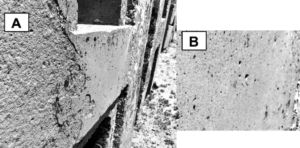
2.2 Scientific investigation: thin sections, optical microscope, SEM/EDS, scanning electron microscope
The Bolivian scientists who carried out the investigation in the 1970s did not perform any similar petrographic study on the andesitic volcanic sculptures. Nineteenth-century travelers had agreed that the andesite stone originated mainly from the volcano Cerro Khapia in the southern part of the Lake Titicaca [19]. More recently Janusek et al. [15] confirmed that the volcano was the principal source of andesitic material at Pumapunku / Tiwanaku. However, they did not perform a regular petrographic study. They relied on qualitative results obtained on volcanic boulders with a portable X-ray fluorescence spectrometer, and not on quarrying remains. This explains why, in this preliminary study, we do not compare geological andesite and monument stone, as we have done with sandstone. In the absence of a geological study, we did not know where to look.
2.2.1 Andesite monument samples.
We mentioned in the Introduction that numerous andesite fragments, heaps of rubbles, are scattered on the site and abandoned. They are outside the protected monument area. By carefully choosing this debris consisting in fact of pieces of monumental stones with the characteristically very flat surface, we were able to get our representative samples. Samples PP1 A and B (Fig 21) are the most important for our study. The sample PP2 was taken at the corner of a broken door fragment and PP5 on the surface of a flat slab.

2.2.2 Optical microscope: thin sections.
In the thin section displayed in Fig. 22 we see, in white, the minute plagioclase feldspar crystals, the large amphibole crystals and pyroxene. In addition, we have black areas of amorphous substance that run across the entire picture.
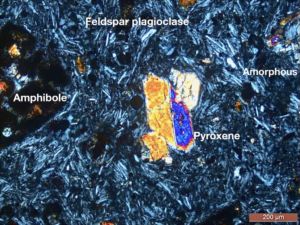
It is interesting to notice that the presence of this amorphous substance was also mentioned by the 19th-century travelers in their thin section cut in a sample of andesite taken from a Tiwanaku monument, different from our PP2 sample [19, in German: "Runde Nester amorpher Substanz, in der Mitte licht braun gefärbt, nach den Rändern verblassend, wurden vereinzelt bemerkt"; English translation: "Round nests (pockets) of amorphous substance, in the middle light brown colored, fading to the edges, were noticed occasionally".].
Under reflecting light, the surface of PP1A shows white feldspar plagioclase crystals and dark elongated minerals which are typical for this type of andesite stone (Fig. 23). The surface is very flat, without any trace of polishing action with abrasive grains nor cutting tool, but dotted with small holes that are 0.2 to 0.5 mm deep with clear edges.
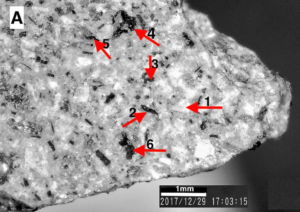
Hole No.4 is 0.5 mm wide (Fig. 23) and contains several grains of minerals and other substances that are part of the core, below the surface. It will be investigated under SEM and EDS analysis in the next section of this paper (Fig. 24). The numbered points in Fig. 23 possess the following mineralogical composition:
No. 1: plagioclase phenocryst on the surface;
No. 2: mica biotite single crystal on the surface;
No. 3: pyroxene-augite crystal on the surface;
No. 4: hole with hornblende crystals, pyroxene-augite crystal and amorphous matter (see description below);
No. 5: hole with minute feldspar plagioclase crystals;
No. 6: hole with pyroxene and amphibole crystals.
The surface of the andesite stone is hard, with a Mohs hardness of 6-7 (7=quartz), and the density is d=2.58 kg/l. [17].
2.2.3 SEM / EDS analysis.
Now we focus on hole number 4 (Point 4) already mentioned above in Fig. 23, with a higher magnification (optical microscope).

On the bottom of the hole of Point 4 (Fig.24 right), we see dark matter made up of several different minerals, surrounded with white feldspar crystals on the surface. The corresponding SEM image on the left contains, on the surface, plagioclase (Plag.) and in the hole hornblende poly-crystals (H), pyroxene-augite (P-A), and a ferro-silicate inclusion (Fe-Si). Then, in between of these crystals, marked with the white square, we find something that does not correspond to any classified mineral from the optical microscope point of view.
At higher magnification, in Fig. 25, we have a surprising totally amorphous element that resembles rubber, and is not like a crystalline mineral. Is this the amorphous matter already mentioned above in the thin section of Fig. 22 ?
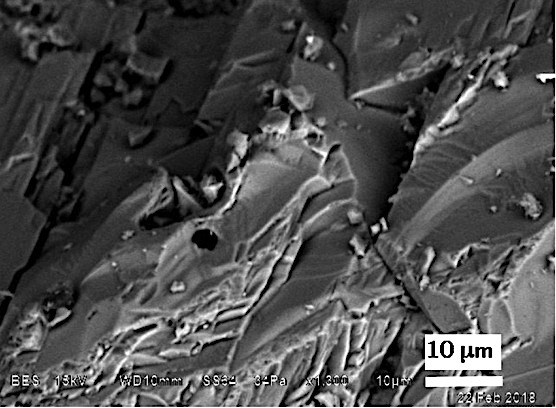
The EDS analysis of Fig. 26, gives a very high amount of carbon C, and also nitrogen N, followed by other mineral elements: Na, Mg, Al, Si, P, S, Cl, K, Ca. As for other light elements, the concentration of the element nitrogen N cannot be determined by simple EDS, but it is qualitatively present in relatively high quantity in this amorphous organo-mineral matter, perhaps an organic ammonium composition.

Surprisingly, we are finding organic matter in a volcanic rock. This is unusual and simply contrary to nature. We can only conclude that this sample is artificial, man-made.
It could be argued that, since this is a SEM image that was taken from a hole located on the surface of sample PP1, what we had been measuring was the result of surface pollution. Therefore, in order to deal with this argument, we looked inside PP1A by cutting from its interior a smaller sample labeled PP1C. We obtained several spots with the same type of organic matter. Fig. 27 displays two of them.
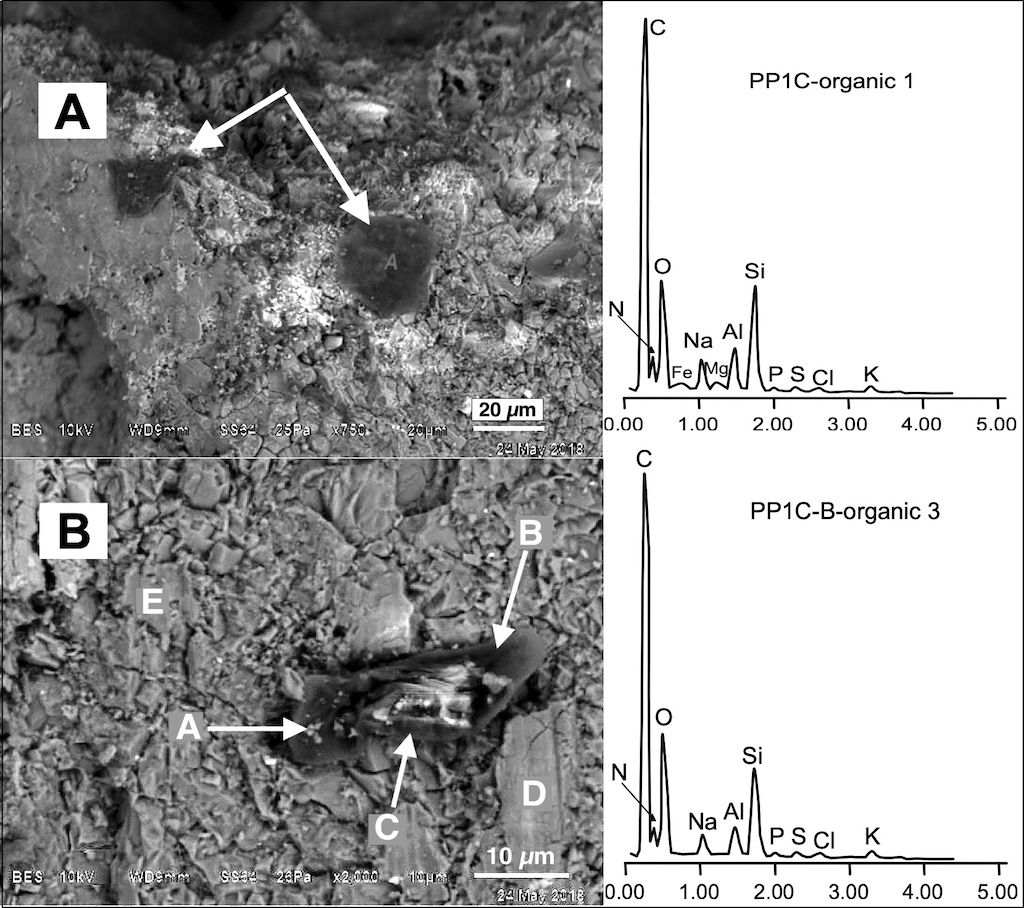
In Fig. 27A, we see a very smooth surface on the left of the first arrow that could be the surface of a binder, but too thin for a realistic EDS measurement. Focusing on the dark spots, we find the same EDS spectrum as in Fig. 26, namely carbon, nitrogen and all the other mineral elements. In Fig. 27B, we see a black system in the middle of the feldspar. It comprises a sheet B lying underneath the crystals A and C and surrounded by other elements D and E. The EDS analysis of the grains A and C gives the element composition of feldspar plagioclase. Then we analyzed the dark sheet B that is lying underneath these two minerals. We again obtain the same spectrum as in Fig. 26; it is organic matter. Thus, we have feldspar plagioclase grains on the top of an organic material. The other grain D contains 70 at.% of Si and could be a type of tridymite SiO2 as described in reference [19]. Crystal E is plain feldspar plagioclase.
2.3 Discussion: which chemistry ?
Everybody will agree with the fact that this organic matter suggests the presence of an artificial stone. So, first conclusions: which chemistry? It is not polysialate-based geopolymer like for the red sandstone megaliths. It is not the alkaline medium. If it is not alkaline medium, then it is acidic medium. And yes, this is acidic medium if we rely on the ancient legends that archaeology doesn't take into account: "(…) una sustancia de origen vegetal capaz de ablandar las piedras". Plant extracts capable of softening stones. This is what the local South American people are telling and reading.
2.3.1 Plant extracts capable of softening stones: carboxylic acids.
40 years ago, Prof. Joseph Davidovits met with a Peruvian anthropologist, Francisco Aliaga, and they decided to make one presentation at an archaeometrical conference in New York, 1981 [20], titled: "Fabrication of Stone Objects by Geopolymeric Synthesis in the Pre-Incan Huanka Civilization in Peru". The excerpt of the Proceedings summary reads: "It is now agreed that the Tiwanaku civilization is modeled on the pre-Incan Huanka civilization revealed by an extraordinary skill in fabricating objects in stones. A recent ethnological discovery shows that some witch doctors in the Huanka tradition, use no tools to make their little stone objects, but still use a chemical dissolution of the stone material by plant extracts, carboxylic acids."
One year later, in 1982, a scientific study carried out with the Laboratory of Pharmacognosy in Grenoble University, France, was published with the title: "The Disaggregation of Stone Materials with Organic Acids from Plant Extracts, an Ancient and Universal Technique." The study focused on the extraction of carboxylic acids from plants and their degrading action of limestone (calcium carbonate). The conclusion of the study stated: "..the pre-columbian farmers were quite capable of producing large quantities of acid from such common plants in their region as: fruits, potatoes, maize, rhubarb, rumex, agave Americana (this is the cactus), ficus indica, oxalis pubescens." [21] [22].
They studied the action of three carboxylic acids:
- acetic acid,
- oxalic acid,
- citric acid.
These carboxylic acids work perfectly with limestone. Limestone is disaggregated by these organic acids. It is very easy to prove and to measure their action. Any stone that contains limestone will be disaggregated but not volcanic andesite. It doesn't work . This chemistry can only be used to fabricate a binder, which, as such, will agglomerate non-consolidated stone material (for example volcanic sand). So, clear-cut between limestone and volcanic stone such as the andesite.
2.3.2 We could disaggregate limestone, but we were not able to re-agglomerate, harden it.
Several people tried to discover the secret of this stone making. They were successful in softening the limestone that they reduced to a soft mass. But they failed to harden it again. This has been the reason, why, 40 years ago, Davidovits and Aliaga stopped their studies. They could disaggregate (limestone) but they were not capable to re-agglomerate it, to harden it again.
The appropriate knowledge was acquired very recently (2 years ago). It applies the basic chemistry dealing with Phosphate-based geopolymers and Organic-mineral geopolymers [23].
2.3.3. Research target, finding the hardener: the guano.
Where can we find, locally, the chemicals that will generate this chemistry? For sandstone we located the alkaline Natron in the Altiplano lake Laguna Cachi, to manufacture the big megaliths. For the volcanic andesite stones, we have an organic binder obtained in an acidic medium, and we are looking for the hardener.
Archaeology is providing diverse hints that are relying on several texts written during the Spanish conquest. They transcribe the explanations provided orally by the native people at that time. One of these texts is dealing with the guano trade between the Pacific Ocean at Ilo and Tiwanaku, going up from the sea level to 3800 meters high (Fig. 28). It has been discussed by J.W. Minkes [24]. The excerpt of the study starts with the site of Ilo on the Pacific Ocean and reads: "5.5.2 El descanso: El Descanso means the 'resting place' in Spanish. This name has been transmitted orally and refers to the traditional use of the site as resting place for the llama caravans on their way to or from the highlands via Moquegua…" According to the historical documents, the Moquegua Valley was the route taken by numerous Llama caravans carrying the guano gathered in large quantities at Punta Coles, Ilo, upwards to Tiwanaku. This trade [guano] appears to have been intensified during the Tiwanaku / Pumapunku construction, possibly stimulated by the need for more guano. The coastal [Ilo] population received coca, camelid wool, dried meat as well as llamas for guano transportation in exchange.

The guano is an excellent fertilizer but we think that this is not the reason why they transported it to the highlands. The Tiwanaku civilization was created before they exploited the guano. At Tiwanaku, they had already developed a very special agriculture known as raised-field system. The fields consisted of elevated, elongated planting beds, surrounded by water-filled ditches. The ditches contained aquatic plankton and small fishes which provided a natural fertilizer [25]. They did not need the guano, because they produced on site their own fertilizer. So, to claim that the guano had been sent to the highlands because they needed it as a fertilizer for the agriculture is not correct. This civilization was developed by itself. We suspect that this guano was not used in agriculture (the exploited quantities are much greater than what would be needed for agriculture alone), but rather, could be one geopolymer organic hardener. Indeed, it contains different chemical ingredients useful for that purpose.
Table 2 displays an analysis that was carried out 150 years ago by Mr. J.D. Smith on specimens of Peruvian guano [26]. It contains a high number of salts of acids, essentially ammonium oxalate and urate, calcium oxalate, ammonium phosphate and calcium phosphate.
Table 2: chemical composition of Peruvian guano containing essentially: ammonium oxalate and urate, calcium oxalate, ammonium phosphate and calcium phosphate after [26].
| Uric acid, urate of ammonia | 17.92 |
| Oxalate of ammonia | 7.40 |
| Chloride and phosphate of ammonia | 8.80 |
| Organic matter | 8.76 |
| Phosphate of lime | 22.00 |
| Oxalate of lime | 2.50 |
| Sulphate of potash | 8.00 |
| Water | 22.00 |
The action of vinegar (acetic acid) or any of the other carboxylic acids extracted from plants, on the guano, yields the formation of phosphoric acid and oxalic acid, useful in the production of phosphate-based geopolymer. The chemistry also involves the addition of alumino-silicate minerals such as finely weathered volcanic tuff, kaolinitic clay or perhaps metakaolin. New research on site is needed in order to determine which mineral was taking part in the making of this organo-mineral geopolymer binder.
2.3.4 EDS of guano compared with PP1 organic matter.
The EDS analysis of the guano sample from Ilo, displayed in Fig. 29, is similar to the EDS of the PP1 / point 4 organic matter (see in Fig. 25-26). The chemical elements are identical, yet, they are present at a lower concentration in the monument, which seems to be obvious. However, at the stage of our present study we do not know whether the PP1 organic matter is the remaining part of unreacted guano or the spectrum of the organo-mineral binder itself.

2.3.5 First conclusion.
The organic matter detected in this study suggests the reaction of an ammonium organic compound (the nitrogen N) from vegetal or animal origin, with minerals, to form an organo-mineral binder. The quantitative analysis of the nitrogen N cannot be carried out with our present equipment. We only got semi-quantitative data. The detection of Cl, P and S is intriguing and could provide some clues for further research. The builders may have transported non-consolidated volcanic andesite tuff having the consistence of sand, from the Cerro Khapia site. They added a type of organo-mineral binder manufactured with local biomass (carboxylic acids extracted from maize and plants), guano and reactive alumino-silicate minerals.
3. Conclusion
The thin section of a sample taken from the Pumapunku red sandstone monument shows grain boundaries made of a thick fluidal red ferro-sialate matrix. To our knowledge, this feature is very unusual in sandstone formed geologically. It represents a unicum and supports the idea of artificial sandstone geopolymer concrete. Complementary SEM/EDS analysis for Na, Mg, Al, Si, K, Ca, Fe suggests that the Kallamarka site is the source for Pumapunku megalithic blocks. The megalithic slabs of between 130 and 180 tonnes were cast 1400 years ago. To make their geopolymer sandstone concrete, the builders may have transported finely weathered, kaolinitized sandstone from the Kallamarka site and added foreign elements such as natron (Na2CO3) extracted from Laguna Cachi, a small lake (salar) located south of the great Salar de Uyuni, in the Altiplano (Bolivia).
However, the most controversial aspect of the Pumapunku site is found in puzzling smaller items made of andesitic volcanic stone. Our study demonstrates that these architectural components were fashioned with a wet-sand geopolymer molding technique. The SEM study of this gray andesite shows the presence of organic matter (it could be the geopolymer binder). We have carbon, nitrogen, and mineral elements. The existence of amorphous organic matter is very unusual, if not impossible in a volcanic stone. It was also detected in the optical thin sections studies. It is a "unicum" and supports the idea of artificial andesite geopolymer concrete. To make geopolymer andesite concrete, the builders may have transported non-consolidated volcanic tuff, which is an andesite stony material having the consistence of sand from the Cerro Khapia site, and added an organo-mineral geopolymer binder manufactured with local ingredients.
Surprisingly, this study demonstrates that the Pumapunku builders mastered two geopolymer concrete methods, namely:
a) – One in alkaline medium for the red sandstone megaliths. This technology is familiar to modern material scientists and civil engineers, and is in line with knowledge of the traditional method of producing geopolymer concrete.
b) – The second, in acidic medium for the gray andesite structures, is based on the use of organic carboxylic acids extracted from local biomass and also the addition of guano. It has been successfully replicated in our laboratory with modern chemicals in order to test the validity of the chemical mechanisms involved in the new geopolymeric reactions.
In the absence of contrary evidence, the present conclusions are sound, and the Pumapunku red sandstone megalithic slabs and gray andesite sculptures are made of ancient geopolymers. This kind of study could provide data on the long-term crystallization mechanisms and mineralogical evolution of geopolymer molecules. In addition, the next step of our study will be to gather enough sample in order to implement Carbon-14 dating and provide the exact age of the monuments.
Acknowledgements
SEM data were collected by Mathilde Maléchaux at Pyromeral Systems SA. 60810 Barbery. France; thin sections were made at UniLaSalle-Geoscience. 6000 Beauvais. France. This research did not receive any specific grant from funding agencies in the public, commercial, or not-for-profit sectors.
References:
[1] J. Davidovits, L. Huaman, R. Davidovits, Ancient geopolymer in South American monument. SEM and petrographic evidence, Material Letters 235 (2019) 120-124. DOI: doi.org/10.1016/j.matlet.2018.10.033.
[2] J. Davidovits, L. Huaman, R. Davidovits, Ancient organo-mineral geopolymer in South American Monuments: organic matter in andesite stone. SEM and petrographic evidence, Ceramics International, 45 (2019) 7385-7389. DOI: doi.org/10.1016/j.ceramint.2019.01.024.
[3] J. Davidovits, Geopolymers: inorganic polymeric new materials, J. Thermal Analysis, 37 (1991), 1633–1656.
[4] J. Davidovits. X-ray analysis and X-ray diffraction of casing stones from the pyramids of Egypt. and the limestone of the associated quarries. in: A.R. David (Eds), Science in Egyptology symposium, Manchester University Press (1986) 11–20.
[5] J. Davidovits, Ancient and modern concretes: what is the real difference?, Concrete International: Des. Constr, 9[12] (1987), 23–29.
[6] C. Nickerson, Did the Great Pyramids' builders use concrete?, The New York Times, April 23, 2008, https://www.nytimes.com/2008/04/23/world/africa/23iht-pyramid.1.12259608.html, (accessed 10 August 2018).
[7] G. Demortier, PIXE, PIGE and NMR study of the masonry of the pyramid of Cheops at Giza, Nuclear Instruments and Methods in Physics Research B, B 226, (2004) 98–109.
[8] M.W. Barsoum, A. Ganguly and G. Hug, Microstructural Evidence of Reconstituted Limestone Blocks in the Great Pyramids of Egypt, J. Am. Ceram. Soc. 89[12] (2006), 3788–3796.
[9] K.J.D. MacKenzie, M.E. Smith, A. Wong, J.V. Hanna, B. Barry, M.W. Barsoum, Were the casing stones of Senefru's Bent Pyramid in Dahshour cast or carved? Multinuclear NMR evidence, Materials Letters 65 (2011) 350–352.
[10] I. Tunyi and I. A. El-hemaly, Paleomagnetic investigation of the Pyramids, Europhysics News 43/6 (2012), 28-31.
[11] A. Vranich, Reconstructing ancient architecture at Tiwanaku, Bolivia: the potential and promise of 3D printing, Heritage Science 6/65 (2018), DOI: doi.org/10.1186/s40494-018-0231-0.
[12] C. R. Markham, Travels of Pedro de Cieza De Leon A.D. 1532-50, Hakluyt Society, London (1864), 376-379.
[13] J.-P. Protzen and S. Nair, Who Taught the Inca Stonemasons Their Skills? A Comparison of Tiahuanaco and Inca Cut-Stone Masonry, Journal of the Society of Architectural Historians, 56/2 (1997), 146-167.
[14] C. Ponce Sangines. A. Castanos Echazu. W. Avila Salinas. F. Urquidi Barrau. Procedencia de las areniscas utilizadas en el templo precolumbio de Pumapunku (Tiwanaku). Academia Nacional de Sciencias de Bolivia (1971) No.22.
[15] J. W. Janusek, P. R. Williams, M. Golitko, and C. Lémuz Aguirre, Building Taypikala: Telluric Transformations in the Lithic Production of Tiwanaku, in: N. Tripcevich and K.J. Vaughn (eds.), Mining and Quarrying in the Ancient Andes, Interdisciplinary Contributions to Archaeology, Springer Science+Business Media, New York, 2013, pp. 65-97.
[16] N. Mu. Y. Fu. H.M. Schulz. W. van Berk. Authigenic albite formation due to water–rock interactions — Case study: Magnus oilfield (UK. Northern North Sea). Sedimentary Geology 331 (2016) 30–41.
[17] J. Davidovits. Geopolymers: Ceramic-like inorganic polymers. J. Ceram. Sci. Technol. 08 [3] (2017) 335-350.
[18] O. Palacios. Geology of the Western and Altiplano Mountains west of Lake Titicaca in southern Peru. Bulletin A42 (1993) 80p.
[19] A Stübel and M. Uhle, Die Ruinenstäette Von Tiahuanaco, Verlag von Karl W. Hiersemann, Leipzig, 1892. http://digi.ub.uni-heidelberg.de/digit/stuebel_uhle1892/0004, (accessed 10 August 2018).
[20] J. Davidovits, F. Aliaga, Fabrication of Stone Objects by Geopolymeric Synthesis in the Pre-Incan Huanka Civilization in Peru, Abstracts of 21st International Symposium for Archaeometry, Brookhaven National Laboratory, New York, USA (1981) page 21.
[21] J. Davidovits, A. Bonett and A.M. Mariotte, Proceedings of the 22nd Symposium on Archaeometry, University of Bradford, Bradford, U.K. March 30th – April 3rd (1982), 205 – 212.
[22] The pdf files of ref. 20 and 21 are in the Geopolymer Institute Library for free download, called Making Cement with Plants Extracts, at #C: https://www.geopolymer.org/library/archaeological-papers/c-making-cements-with-plant-extracts/ .
[23] See Chapter 13 and Chapter 14, in J. Davidovits, Geopolymer Chemistry and Applications, Edition: 2nd (2008), 3rd (2011), 4th (2015), Publisher: Institut Géopolymère, Geopolymer Institute, Saint-Quentin, France, Editor: ISBN: 9782951482098 (4th ed.)
[24] J.W. Minkes, Wrap the Dead, Archaeological Studies Leiden University, 12, (2005), Chapters 5.5.2, 6.5.2.
[25] A.L. Kolata, The technology and organization of agricultural production in the Tiwanaku State, Latin American Antiquity, 2(2) (1991), 99-125.
[26] J. Towers, Guano and its analysis, The British Farmer's Magazine, (1845) Vol. 9, 389-400.
This study is also available in the GEOPOLYMER LIBRARY for free download. Go to #K-eng. Tiahuanaco geopolymer artificial stones
How Where Ruins of Puma Punku in Tiahuanaco, in South America
Source: https://www.geopolymer.org/archaeology/tiahuanaco-monuments-tiwanaku-pumapunku-bolivia/
0 Response to "How Where Ruins of Puma Punku in Tiahuanaco, in South America"
Post a Comment